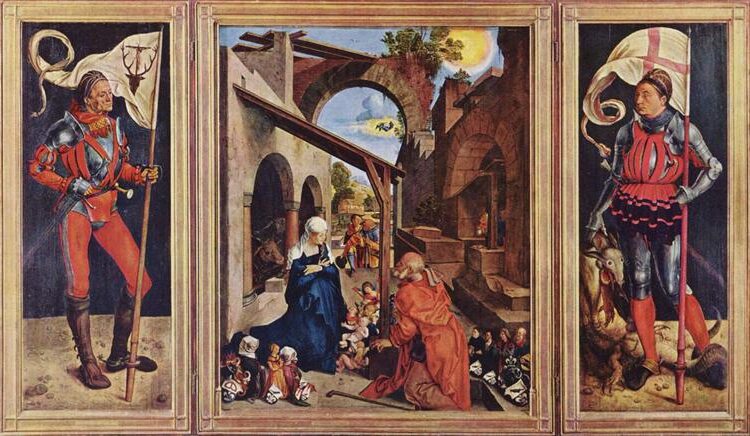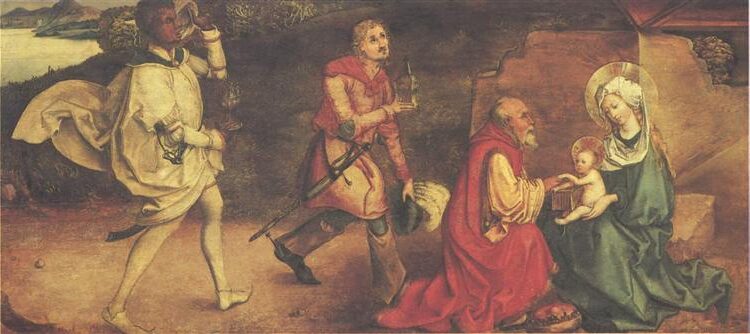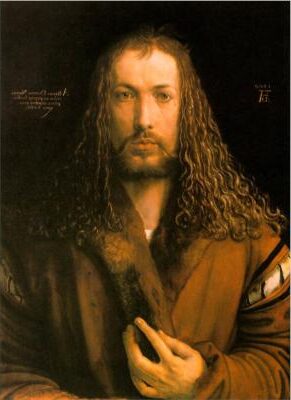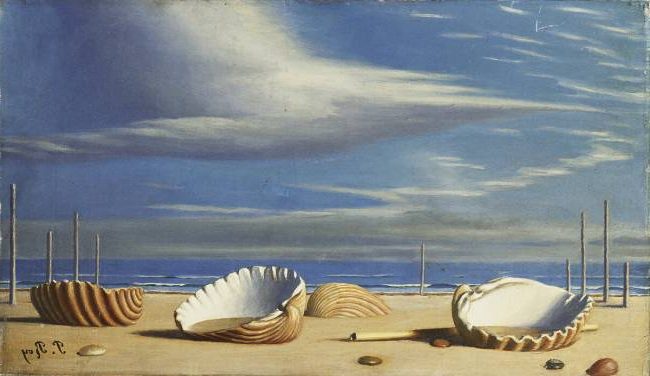Albrecht Dürer: Painter and Master of the Northern Renaissance
Born: 21 May 1471, Free Imperial City of Nuremberg, Holy Roman Empire
Death: 6 April 1528, Free Imperial City of Nuremberg, Holy Roman Empire
Art Movement: Northern Renaissance, High Renaissance
Nationality: German
Teacher: Martin Schongauer
Albrecht Dürer: Painter and Master of the Northern Renaissance
Early Life and Apprenticeship
Albrecht Dürer’s formative years in Nuremberg laid the foundation for his extraordinary artistic career. His early training combined his father’s goldsmith discipline with formal apprenticeship under one of the city’s leading artists.
Nuremberg Roots and Artistic Beginnings
Albrecht Dürer was born on May 21, 1471, in Nuremberg, Germany, a thriving center of craft and commerce. His father, also named Albrecht, was a skilled Hungarian goldsmith who had settled in the city after training in the Netherlands.

Paumgartner Altarpiece (c. 1503) by Albrecht Dürer
Young Dürer initially trained in his father’s goldsmith workshop, where he learned precision and attention to detail—skills that would later define his artistic style. Despite his father’s intention for him to follow in the goldsmith tradition, Dürer showed remarkable drawing talent from an early age.
His earliest known self-portrait was drawn with silverpoint at age 13, demonstrating his precocious ability. This early training in metalwork gave Dürer an advantage in understanding materials and techniques for his later engraving work.
Training Under Michael Wolgemut
In 1486, at the age of 15, Dürer’s father arranged for his apprenticeship with Michael Wolgemut, Nuremberg’s leading painter and woodcut designer. Wolgemut operated a large workshop that produced various artworks, particularly altarpieces.
During his four-year apprenticeship, Dürer learned fundamental painting techniques and the craft of woodcut design. Wolgemut’s workshop specialized in producing illustrations for books, giving Dürer exposure to print production methods.
This training proved crucial for Dürer’s development, as he absorbed both traditional German artistic techniques and innovative approaches to printmaking. Wolgemut’s influence is evident in Dürer’s early works, though the pupil would soon surpass his master in technical skill and artistic vision.
By the completion of his apprenticeship in 1489, Dürer had mastered the basics of his craft and was ready to embark on his journeyman years, traveling to expand his artistic horizons.
Artistic Development and Major Works

Feast of the Rosary (1506) by Albrecht Dürer
Dürer’s artistic journey spanned multiple techniques and influences, making him a versatile master whose work bridged Northern European tradition with Italian Renaissance innovations. His development shows a constant pursuit of perfection in proportion, perspective, and artistic expression.
Influence of Italian Renaissance and Northern Europe
Dürer made two pivotal journeys to Italy, first in 1494-1495 and again in 1505-1507, where he absorbed Renaissance principles. In Venice, he studied with Giovanni Bellini, whose use of color and light transformed Dürer’s approach to painting. These Italian influences merged with his Germanic foundations, creating his distinctive style.
His Venetian period produced works with softer modeling and richer colors than earlier paintings. Dürer wrote that while in Italy, he was both admired and criticized by local artists who appreciated his technique but disliked his distinctly Northern style.
Back in Germany, Dürer synthesized Italian perspective and proportion with the meticulous detail typical of Northern European art. This fusion created works that appealed across European artistic traditions.
Notable Paintings and Engravings
Dürer’s self-portraits stand among his most recognizable works, including his 1500 Self-Portrait at 28, which presents him in a Christ-like pose with remarkable technical skill. This painting demonstrates both his artistic ability and his elevated view of the artist’s status.


“Adam and Eve” (1507) showcases his mastery of human proportions and classical ideals. The copper engraving displays anatomical precision and balanced composition that exemplifies his Italian influence.
His religious works, including numerous Virgin and Child paintings, blend devotional feeling with human warmth. “The Feast of the Rose Garlands” (1506), created in Venice, demonstrates his ability to work in Italian Renaissance style.
“The Four Apostles” (1526) represents the culmination of his painting career. These panels show monumental figures with psychological depth and technical perfection.
Advancements in Printmaking
Dürer revolutionized printmaking, elevating it from a reproductive medium to a true art form. His woodcut series “The Apocalypse” (1498) showcased unprecedented detail and dramatic power, demonstrating that prints could convey complex emotions and narratives.
He mastered copper engraving with works like “Melencolia I” (1514), which displays symbolic complexity and technical brilliance. The meticulous detail in “Saint Eustace” and “Knight, Death and the Devil” demonstrates his unmatched control of the burin.
Dürer pioneered drypoint engraving, creating velvety shadows and atmospheric effects previously impossible in prints. He also developed innovative techniques for creating tonal gradations in woodcuts.
His theoretical writings on proportion and perspective formalized his artistic innovations, ensuring his influence lasted centuries. These printmaking advances established Dürer as not just a great artist but a technical innovator who forever changed the medium.
Legacy and Impact

Christ Among the Doctors (1506) by Albrecht Dürer
Albrecht Dürer’s work transcended his lifetime, shaping the course of Western art through his innovative techniques and humanistic approach. His mastery of proportion, detail, and technical skill established new standards in printmaking and painting.
Contribution to Art and Humanism
Dürer revolutionized printmaking, elevating it from a craft to a respected art form. His detailed engravings displayed unprecedented technical precision and artistic expression.
The artist’s connection to Humanism appears throughout his work, combining scientific observation with artistic beauty. His studies of human proportions and mathematics reflected Renaissance ideals of understanding nature through rational inquiry.
Emperor Maximilian I recognized Dürer’s genius, appointing him as court artist to the Holy Roman Empire. This royal patronage allowed him to create monumental works that merged artistic brilliance with political messaging.
In his theoretical writings, Dürer documented artistic techniques and mathematical principles. These texts became crucial educational resources for generations of artists and craftsmen.
Influence on Future Generations
Dürer’s prints circulated widely throughout Europe, inspiring countless artists for centuries. His technical innovations in woodcuts and engravings established techniques still studied in art schools today.

A Lobster (1495) by Albrecht Dürer
Major museums including the Louvre, Uffizi, Metropolitan Museum of Art, and National Gallery showcase his works as cornerstones of Renaissance art. The Albertina in Vienna holds the world’s largest collection of his drawings and prints.
His self-portraits, including the famous 1500 self-portrait that resembles Christ, pioneered a new form of artistic self-representation. This approach influenced how artists portrayed themselves for generations.
German national identity became deeply connected to Dürer’s legacy. The Germanisches Nationalmuseum in Nuremberg preserves his home and many original works as cultural treasures.
His detailed nature studies, like “Young Hare” and botanical illustrations, established new standards for scientific observation in art that influenced both artistic and scientific development.
Frequently Asked Questions
Albrecht Dürer transformed Renaissance art through innovative techniques and profound artistic vision. His mastery of printmaking, painting, and theoretical work established him as Germany’s greatest Renaissance artist with influence across Europe.
What are some notable contributions of Albrecht Dürer to the Renaissance art movement?
Dürer is credited with bringing the Renaissance to Northern Europe, bridging Italian Renaissance ideals with northern European artistic traditions. He elevated printmaking to a fine art form, giving it the same status as painting.
His theoretical writings on perspective, proportion, and human anatomy helped standardize these concepts for other artists. Dürer’s detailed nature studies and realistic representations of animals and plants showed remarkable scientific observation.
He introduced self-portraiture as a significant art form, creating some of the earliest and most psychologically complex self-portraits in Western art.
Which techniques did Albrecht Dürer pioneer in printmaking?
Dürer mastered and revolutionized woodcut printing, bringing unprecedented detail and tonal range to the medium. He elevated woodcuts from simple illustrations to sophisticated art forms.
His engraving technique achieved extraordinary detail and subtle gradations of light and shadow. Dürer’s precision with the burin (engraving tool) set new technical standards for generations of printmakers.
He also experimented with etching, helping to develop this technique in its early stages. His innovations in printmaking allowed for more widespread distribution of his images throughout Europe.
Can you name the most celebrated works of Albrecht Dürer?
“Melencolia I” (1514) is one of his most famous engravings, filled with symbolic elements and mathematical references. “Knight, Death, and the Devil” (1513) demonstrates his masterful engraving technique and profound philosophical content.
“Four Horsemen of the Apocalypse” from his Apocalypse woodcut series displays his dramatic narrative abilities. His watercolor “Young Hare” (1502) shows his remarkable observational skills and technical precision.
“Self-Portrait at 28” (1500) is particularly notable for its frontal Christ-like pose and psychological intensity. “Adam and Eve” (1504) demonstrates his interest in ideal human proportions and classical forms.
How did Albrecht Dürer’s upbringing influence his artistic career?
Born in 1471 in Nuremberg, a thriving German town, Dürer grew up in a goldsmith’s workshop run by his father. This early exposure to metalwork likely influenced his precise approach to line and detail.
His godfather was the publisher Anton Koberger, which may have sparked his interest in printmaking and book illustration. Dürer’s hometown was an important commercial and cultural center, exposing him to diverse artistic influences.
He traveled extensively as a young artist, including journeys to Italy where he absorbed Renaissance principles. These travels broadened his artistic vision and technical knowledge considerably.
What impact did Albrecht Dürer have on future generations of artists?
Dürer’s detailed prints were widely distributed throughout Europe, serving as models for countless artists. His theoretical writings became standard texts in art education for centuries after his death.
His realistic approach to nature and human anatomy influenced northern European art for generations. Dürer’s symbolic imagery and intellectual approach to art creation impacted conceptual aspects of later artistic movements.
His technical innovations in printmaking established methods that remained relevant for centuries. Many artists directly studied his work, preserving his influence through direct lineages of artistic training.
In which ways did Albrecht Dürer interact with Italian Renaissance artists?
Dürer traveled to Italy twice, in 1494 and 1505-07. There, he studied works by Italian masters. He particularly admired Giovanni Bellini and was influenced by Leonardo da Vinci’s theories on proportion.
He exchanged ideas and artwork with Italian contemporaries, including Raphael. Dürer incorporated Italian Renaissance principles of perspective, proportion, and classical beauty into his northern European artistic sensibility.
His adoption of Italian humanist ideas helped him develop a theoretical foundation for his art. Dürer’s integration of Italian Renaissance influences with German artistic traditions created a distinctive northern Renaissance style.








